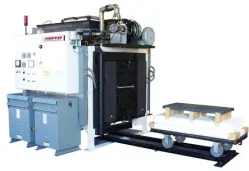Kilns for Ceramic Membranes like Solid Oxide Fuel Cells (SOFC)
A Solid Oxide Fuel Cell (SOFC) is an electrochemical conversion device (ceramic membrane) that produces electricity directly from oxidization of a fuel. Fuel cells are characterized by their electrolyte material; the SOFC use a hard, non-porous compound, a solid oxide or ceramic, as electrolyte. Advantages of fuel cells include high efficiency, long-term stability, fuel flexibility, low emissions and relatively low cost. SOFCs are expected to be approximately 50%–60% efficient at converting fuel to electricity. In applications designed to capture and utilize the system's waste heat (co-generation), overall fuel use efficiencies could top 80%–85%. Solid oxide fuel cells operate at very high temperatures—around 800°C (1,472F). High-temperature operation removes the need for precious-metal catalyst, thereby reducing cost. It also allows SOFCs to reform fuels internally, which enables the use of a variety of fuels.
SOFCs are also the most sulfur-resistant fuel cell type; they can tolerate several orders of magnitude more sulfur than other cell types. In addition, they are not poisoned by carbon monoxide (CO), which can even be used as fuel. This property allows SOFCs to use gases made from coal.
The high-temperature operation solid oxide fuel cell has disadvantages. It results in a slow startup and requires significant thermal shielding to retain heat and protect personnel, which may be acceptable for utility applications but not for transportation and small portable applications. The high operating temperatures also place stringent durability requirements on materials. The development of low-cost materials with high durability at cell operating temperatures is the key technical challenge facing this technology.
Scientists are currently exploring the potential for developing lower-temperature fuel cell furnaces that operate at or below 800°C, have fewer durability problems, and cost less. Lower-temperature SOFCs produce less electrical power, however, and materials that will function reliably and efficiently in this lower temperature range have not been identified.
Current advanced work in ceramic membrane and fuel cell technology is testimony to the advancement of our ceramic science. Such innovations would not have been possible without the simultaneous development of advanced fuel cell furnace designs capable of the world-class performance necessary to support this technology.
Furnaces for the processing of ceramic membranes and solid oxide fuel cell devices require the integration of complex process heating and control systems for organic binder burnout followed by a sintering process. Solid oxide fuel cell furnace designs are further complicated by the addition of structural refractories to support and carry the load setting.
Experience counts when it comes to developing new advanced ceramic materials and electro-ceramic devices. A well-matched combination of knowledgeable materials science design, together with an experienced furnace and controls design team, will provide the most successful path to continued, rapid and successful commercial development of ceramic science technologies and products.
Fuel Cell Furnace Types
- Shuttle kilns
- Envelope kilns
- Assembly and test furnaces
Contact Keith Company to order a solid oxide fuel cell furnace for your application, or for more info on any of our products.











